
|   |

|   |
 e-mail: leelakaverivenkat@gmail.com Parampara finds the right dance/music blend Photos courtesy: Natya Tarangini October 6, 2017 Natya Tarangini's 'Parampara' festival (Sept 22 - 24) observing its 21st consecutive year of celebration, attracted large audiences to the Kamani Auditorium, Delhi, for what, this year turned out to be fare offering a magical dance/music blend. Shivaleela, the inaugural Kuchipudi event by the host organisation featuring the entire Reddy family of Raja/Radha and Kaushalya (nattuvangam) with their two dancing daughters Yamini and Bhavana, in the well rehearsed tautness of presentation - was a more evolved production than what one was treated to during its less formal premiere at the Reddy home on Shiva Ratri. 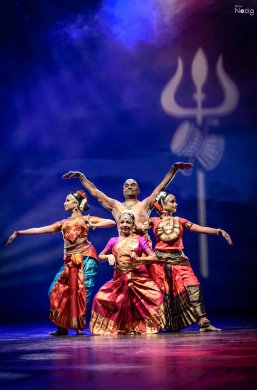 The Reddys Photo: Rahul Naag The senior couple as Shiva and his consort Parvati made brief appearances at the start and towards the finish, with the main burden of the presentation resting on the shoulders of youngsters Yamini and Bhavana. Inspired by Appayya Dikshitar's composition of Shiva who is Swayambhoo, presiding over the life cycle of creation, sustenance and destruction, the work portrayed the many deeds of Shiva as Neelakantha, the blue-throated Lord who contains the poisonous fumes emerging from the breath of Vasuki, the serpent, used as a rope to churn the ocean, by the Gods and Demons in search of the ambrosia of life for immortality (set to music in Sama), Shiva who saves his devotee Markandeya from Yama's noose of death (set to raga Revati) and Shiva who with his third eye reduced Manmatha, the God of love, to ashes. Set to raga Kalyani was the segment of Shiva disguised as the old man testing Parvati taunting her as to what she saw in this strange ash-smeared, tiger-skin clad, serpent- garlanded being, to fall in love with, and set to a peppy Mohanam raga was Kiratarjuna encounter when Shiva as the hunter stakes his claim for having brought down the same boar as Arjuna's arrow was supposed to have. Next was Shiva as Tripurantaka when he destroyed the three cities of the three demons riding in a chariot with Brahma as charioteer, Meru as the churning rod, Vasuki as string for the bow, Vishnu as his arrow, Earth as the chariot and the Vedas as the horses with Surya and Chandra as the wheels. The accompanying music was in Pantuvarali. The episode of Shiva as the Cosmic Dancer was set to raga Vasanta. These encounters enacted between Yamini and Bhavana saw excellent understanding between the two, both adept at quickly switching from a destructive to a benevolent role - for example, Yamini was Shiva to Bhavana's Markandeya, or to the thoughtlessly mischievous and ebullient Manmatha. The last part saw the entire troupe dance together to raga Suratti. Singer Deevi Ravinath, with more familiarity (than felt on the earlier occasion) with the words and raga provided adequate support with Kaushalya Reddy providing the lead with her nattuvangam. In minimal sahitya repetitive lines to be sung like a refrain over a period of an entire scene, can be strenuous for any singer. V.S.K Annadurai on violin, M. Anantha Krishna on flute and B. Bhasker Rao, the well tried mridangist for the Reddys for years, made up the rest of the coordinated music team. 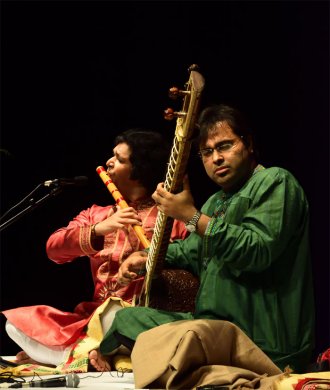 Purbayan Chatterjee and Rakesh Chaurasia Photo: Anant Sachdeva The second half saw a jugalbandi in raag Behag in an Alap, Jod, Jhala between sitarist Purbayan Chatterjee and flautist Rakesh Chaurasia. Rakesh's manodharma had a sobriety against which the virtuosity of Purbayan's interventions at points, made for a not always welcome contrast - the cleverness overriding the melodic raga virtues. 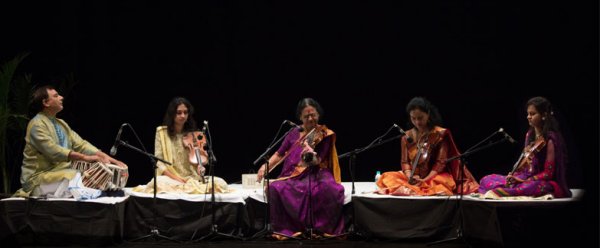 Dr. N Rajam and group ; Photo: Saransh Photography The second evening saw a long queue outside Kamani, to hear what in effect turned out to be most enriching musical fare. With dark clouds and a rain hit day, Dr. N. Rajam, the Hindustani violin maestro with daughter Dr. Sangeeta Shankar, and granddaughters Ragini and Nandini Shankar playing Miya ki Malhar, with Akram Khan for tabla support, provided a delectable concert - where each of the four contributed with Dr. Rajam's lead to create a smorgasbord of classical melodic enchantment. What was amazing was not only the variety in creative imagination and manodharma but also the complete togetherness in the bowing whenever the four played together sounding like one regal violin at play. Just a glance from Rajam was enough indication for the solo or group interventions. After this came a typical Benarsi Kajri. The thunderous ovation at the end told its own tale. 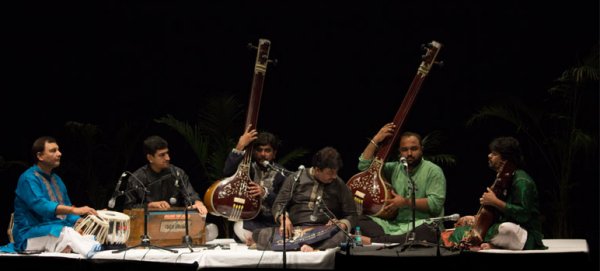 Ustad Rashid Khan and group ; Photo: Saransh Photography Ustad Rashid Khan, whose fame always travels before him, presented Khayal in raga Megh, his considerable entourage comprising talented accompanists being Akram Khan again as percussionist, Murad Ali on sarangi and Vinay Mishra on harmonium, along with two of his disciples singing from the back. One felt that the recital was low key - his musical imagination restricted and unable to attain full flow. Even the Bade Ghulam Ali Khan favourite "Yaad pyagi ayi..." was not in the usual vein. 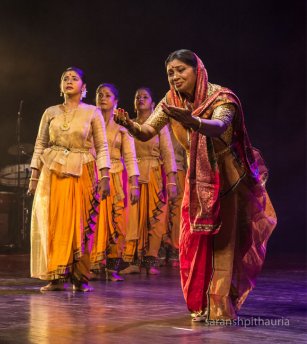 Rajashree Shirke & group Photo: Saransh Photography On the last evening, Rajashree Shirke with her disciples started with the group in a cluster formation on stage, swaying as one block gently from side to side, to then move on to the prayerful silence of freezes in homage to the Devi set to ragas Bairagi and Saraswati followed by some chosen sequences of uthan, thata,toda, tukra, paran in teen taal, with students singly or in groups performing. Then came the best part of the evening with Ravan-Mandodari Samvaad, in the old Kathakaar's style as performed in the temple enclosures, for which Rajashree is known. With just a small group of dancers, the Kathak and theatre blend kept the entire audience engrossed with the narrative and enactment, portraying Mandodari trying to impress upon her husband Ravana that his desire for Sita with the kind of action the craving had led to, was bound to be defeated in war, wherein victory would be Rama's. Defying her, Ravana, after a last frustrated encounter with Sita for her scant regard for his love, despite the promise to make her his chief queen above Mandodari, proceeds to war and is killed. What is laudable about Rajashree's production is how the entire atmosphere is built up with just a few deft steps - loud parhant with footwork suggesting a march of soldiers, or a laughter suggesting Ravana's arrogant certainty in his superiority, or the gleefully awkward jumping step showing the monkey sena crossing over to Lanka. The group in a chorus like mood evoking body, performs round Rajashree who with just a veil covering or uncovering the head becomes now Mandodari and now Ravana. And the slender musical team of just three persons, singer Mayur Mahajan, an excellent percussionist in her son Aniruddha Shirke playing a range of mnemonics on tabla, pakhawaj, drums and some tinny instruments, the variety of rhythmic tones to suit myriad moods of war, of peace, of pathos making the presentation most gripping. And what a great idea to present as a fleeting glimpse the composition "Sheshphun Dagamagio" (where the great snake coiled on the ocean floor shakes) powerfully suggesting what an earth shaking encounter is about to take place with the powerful Rama and the might of Ravana in a war of opposition. The end with the chanting "Rame Rameti..." from Vishnu Sahasranamam was very apt bringing in the meditative mood. 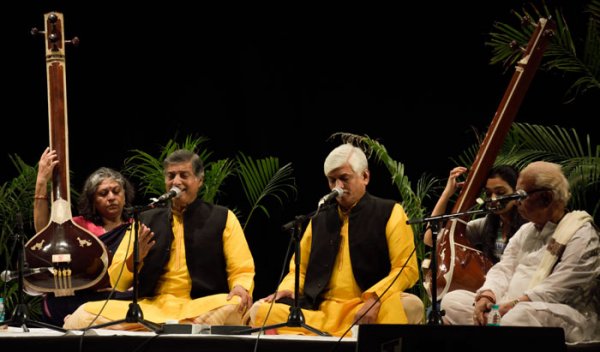 Gundecha Brothers Photo: Anant Sachdeva The finale of Dhrupad by the Gundecha Brothers saw raga Jog treated with all the depth in the alap giving a complete demonstration of what Dr. Pandit Rajshekhar Vyas, rudra veena player had spoken of in his lucid introduction to the art of Dhrupad about how the sound of notes is produced from different regions of the singer's lower throat, the nasal passage and finally higher spaces in the head. A truly inward looking experience with many in the auditorium sitting with eyes closed! The great blessing was to have a discerning audience!  Writing on the dance scene for the last forty years, Leela Venkataraman's incisive comments on performances of all dance forms, participation in dance discussions both in India and abroad, and as a regular contributor to Hindu Friday Review, journals like Sruti and Nartanam, makes her voice respected for its balanced critiquing. She is the author of several books like Indian Classical dance: Tradition in Transition, Classical Dance in India and Indian Classical dance: The Renaissance and Beyond. Post your comments Please provide your name and email id when you use the Anonymous profile in the blog to post a comment. All appropriate comments posted with name & email id in the blog will also be featured in the site. |